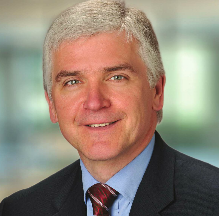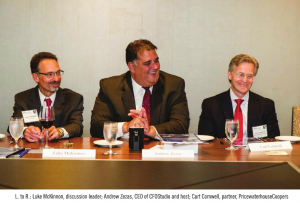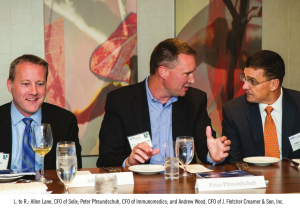As Seen in CFO Studio Magazine Q4 2015 Issue
SCHOOLED IN CHEMICAL ENGINEERING, BURKHARD ZOLLER LEARNED TECHNICAL CONTROLLING ON THE JOB AND LIKED IT
Perfectly at home discussing methacrylates and performance polymers, Burkhard Zoller, CFO for Evonik Corp. – North America, has spent 30 years with the chemical company based in Essen, Germany, starting right out of college as a plant engineer. Three decades and 11 jobs later, he is experienced at running plants and business units. He has also run finance and strategic projects, and was controller for two different business units for about seven years. All this serves him well day-to-day in his current job.
And when he scrutinizes acquisition targets, he gives them the once-over in two ways. He examines the financials and the balance sheets, as all CFOs do, but he also evaluates the firm’s technology to ensure that it’s not only capable of what the target company claims, but is also a good fit with Evonik’s extraordinarily broad portfolio of applications. Zoller, whose master’s degree is in chemical engineering, is a different type of CFO for our times. But he’s not unique in this particular regard. According to a Bank of America report titled “Evolving Role of the CFO,” 63 percent of CFOs are taking on strategic responsibility for technological advances.
For Zoller, having such a skill set is useful with the Board of Directors when presenting the reasons for a proposed acquisition. “You can only put so much information into a paper and present it to the chairman, or in our case, chairwoman. In the meeting, additional questions pop up and I’m in a good position to know about the environmental issues, about the technical issues, about the market access, about the competition, and so on. And that way, I’m very helpful in the decision-making process.”
Diverse Products and Skills
With historic roots dating from the beginning of German industrialization in the first half of the 19th century, the contemporary Evonik Industries was established in 2007 from a lineage of predecessor specialty-chemical companies. Its products, says Zoller, “are in everybody’s life.” Its chemicals are in consumer products like toothpaste and soap. Its polymers are in pill coatings for delayed release of the drug as well as taste masking and moisture protection to make pharmaceuticals more palatable and long acting. Evonik products also make spices more free-flowing and make airplane wings more lightweight.
To keep the inventions coming and to tap into megatrends, R&D is essential. “We spend more than 3 percent of our revenue on R&D,” says Zoller. “We always have projects in the innovation pipeline. Evonik has an intellectual property department here in North America because we had too many ideas to have it done in the central patent department in Germany.” As CFO, one of his focuses, he says, will be to keep money flowing to innovation.
Prior to stepping into his CFO job in 2014 — overseeing finance, tax, IT, and several service units, including energy management, for Evonik’s U.S., Canada, and Mexico operations from offices in Parsippany, NJ —Zoller had several notable shifts in responsibility and title. One of the most important was when he became vice president and controller for the Methacrylates business unit of Degussa AG (an Evonik predecessor). For the first time his job was to look at numbers and think of probabilities. “Accounting is describing what happened last year, putting it in a financial statement. But controlling is looking forward,” he says. “That’s an important part of today’s business. You can’t wait until it’s too late. You have to correct the direction the company’s going, and that’s what controlling is about.”
In that role, he also headed up strategy, and in consultation with the business unit’s head, contributed to decision-making and business development. He advised pursuing acquisition of a company that is still a major part of Evonik’s U.S. business, Evonik Cyro. The acquisition was completed in 2005. “We were on a growth path,” he says. “From then on, we grew.”The methacrylates business expanded from a largely European one to North America and Asia. “It was a very interesting time. We were touring, doing the roadshow to get the approval for this big expansion course, and we actually succeeded. When I started as the controller in that unit we had 270 million euros in revenue, and when I left seven years later, we had 1.4 billion.”
Deeply Involved
Besides his dual background in chemistry and finance, Zoller is an atypical CFO in other ways, as well. To clear his head, he might take off on a motorcycle trip for several days. In early summer, he and a friend rode touring bikes from New Jersey, where he lives, to the White Mountains of New Hampshire, and up Mount Washington for the view. “I’ve driven motorcycles all my life,” he says. “It’s my way to get a fresh mind. You can’t think of anything else when riding a motorcycle.”
One might guess there’s a bit of a risk-taker in such a personality, but he is certainly not that. Asked about the most beneficial contribution a CFO can make to his company, he says, “Keep the company out of financial trouble. That’s the core. The old traditional CFO tasks are still the most important.”
He says the most exciting part about his job is “being involved in everything. Having this broad knowledge about the company, and being able to talk to everybody in the company and outside.” Recently, he says, he enjoyed a lengthy conversation with a major tire manufacturer’s head of innovation and was able to speak knowledgeably about a green tire ingredient Evonik makes.
In July, a new Evonik innovation hub opened in Richmond, VA. “We’ll create new jobs there — and I also want to bring more manufacturing to North America. The United States has an advantage in raw material, in energy costs, and it is a steady, growing market, one of the biggest in the world,” says Zoller. “I’ll try to get more investment over here.”






